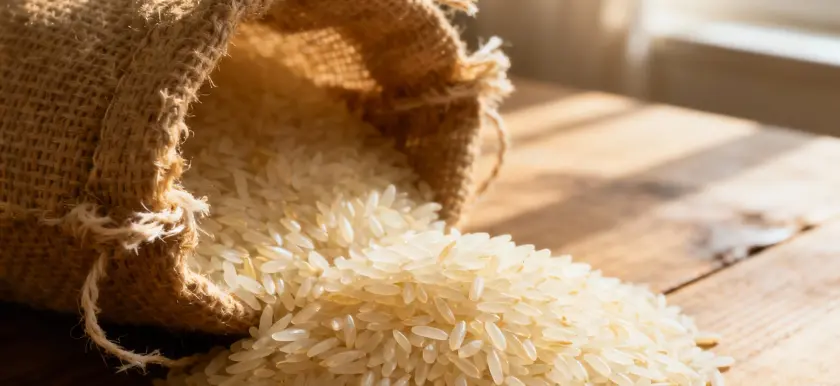Basmati rice is one of the most popular long-grain rice varieties found and consumed in India. Its famous aroma and fluffy consistency are a prime reason for it being the favorite rice in Indian cuisine, making it a staple in both everyday meals and festive gatherings.

What distinguishes basmati rice from other rice varieties is its aroma, long, slender grains, and sumptuous, soft, non-sticky texture. For these reasons, you will find basmati rice in every kitchen across India and around the world.
In addition to its flavor and texture, the health benefits of basmati rice, including easy digestion and a low glycemic index, have also contributed to its popularity. Basmati rice became everyone’s preferred aromatic grain due to its unique characteristics.
Let’s explore the origins, unique qualities, and health benefits that made basmati rice a timeless favorite.
Origins and History of Basmati Rice
Basmati rice was first cultivated in the foothills of the Himalaya in India and Pakistan, where the soil, climate, and manner of cultivation naturally suited the aroma and texture of this unique grain. Farmers cultivated it for centuries following traditional and natural means, letting the rice evolve and become recognized for its long grains and unique aroma.
Basmati rice has a long history as a premium variety and often appears on royal tables or at celebrations. The taste and fragrance of basmati rice, along with its delicate texture, take basmati rice out of the realm of rice and bestow it with its own uniqueness within Indian cuisine.
Over time, people began to recognize not just its flavor but also its versatility and health benefits. These combined qualities – taste, aroma, and nutrition helped basmati rice become the favorite rice in India and eventually a sought-after grain worldwide.
What Makes Basmati Rice Unique
Basmati rice stands out for several key qualities:
- Long and slender grain: When cooked, the grains are light and detach to give a light, elegant feel on the plate.
- Distinctive aroma: The aroma of the grain adds a distinctive quality to every dish, which is why it is one of the most popular choices in Indian kitchens.
- Types of aromatic rice: This type includes traditional basmati and aged basmati varieties. Aged grains offer a more intense aroma and are slightly longer than traditional grain for your special recipes.
- Soft and fluffy texture: Unlike sticky rice, basmati rice is light and fluffy when cooked, making it ideal for biryanis, pulaos, and special occasions.
These qualities together explain why basmati rice became favorite rice of India and one of the most popular aromatic rice varieties globally.
Basmati Rice Benefits for Health
Basmati rice is not only loved for its aroma and texture but also for its nutritional advantages. Here’s why it’s considered a healthier rice option:
- Low glycemic index: Aids in regulating blood glucose levels, which is beneficial for persons with diabetes.
- Easier digestion: Light, fluffy grains are gentle on the stomach and easier to digest than other varieties of rice.
- Nutrient-rich grains: They are a source of complex carbohydrates, proteins, as well as vitamins and minerals in small amounts.
- Weight management benefits: Its low glycemic index and digestibility make it a good food choice for meals within a healthful lifestyle or those focusing on healthy eating.
These factors contribute to the health benefits of basmati rice, explaining why it is a preferred choice in Indian households and among health-conscious individuals.
Popularity in Indian Cuisine and Beyond
Basmati rice has undeniably established itself as the favorite rice in India, with its unique scent, texture, and versatility. It is a primary element of traditional cuisine, particularly for dishes such as biryani or pulao, and is often used during special occasions. The long, fluffy grains elevate every recipe, particularly because of the lovely fragrance.
Apart from India, basmati rice has won the hearts of food lovers everywhere. Its fragrant quality and beautiful appearance make it a common sight in just about every international kitchen, from Middle Eastern rice dishes to Western gourmet meals.
Basmati is one of the aromatic rice varieties that is flavorful, wholesome, and consistent. All of those factors of flavor, aroma, and nutrition contribute to generations and years of cooks and families making basmati their rice of choice.
How to Choose and Use Basmati Rice
Choosing the right basmati rice and cooking it properly brings out its aroma, flavor, and texture. Here are some simple tips:
- Look for long, slender grains and a natural aroma to ensure high-quality basmati.
- Rinse the rice gently before cooking to remove excess starch.
- Soak the rice for 20–30 minutes to achieve fluffy, separate grains.
- Use the correct water-to-rice ratio for perfect texture.
Enjoy it in biryanis, pulaos, or as simple steamed rice to experience the true flavor of these aromatic rice varieties.
Conclusion: Embrace the Aroma and Basmati Rice Benefits
Basmati rice has been adored for its fragrance, long grains, light texture, and health properties. Its unique attributes have made it an eternal choice not just in the kitchens of India but also all over the world, thus from daily dishes to gala meals.
It is very important to select good-quality basmati rice in order to get the original taste and the fragrance of basmati. At Vora Spice Mills, we source basmati rice with great care and pack it so that the natural aroma and taste are retained. Our range lets you enjoy the wonderful flavor and health benefits of this aromatic rice variety from your kitchen to your dining table, anytime.


